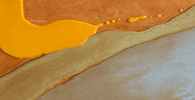Concrete polishing has made numerous advances in the last several years including the use of color in the polishing process. In the past when a polished concrete floor required color, options were limited to integrally coloring the slab or adding a dry shake color hardener. Now with the use of solvent based dyes, it possible to add translucent shading as well as bright, vivid primary colors.
Acid stains have been used successfully and unsuccessfully with polished concrete. Acid stains are designed to react with the cream or cement rich top surface of the concrete. But because this part is removed or ground off during the initial grinding process, the final product in not the rich, mottled look you are used to with acid stains, but more of a monotone finish.
Solvent based dyes have brought a whole new richness to the polished concrete world. Solvent-based dyes, as opposed to acid stains, are formulated to carry the color into the slab through the use of acetone. The size and characteristics of the dye formulations' molecular structure is small enough to be driven below the surface." Most of the time, the appearance of the dyes will be monolithic, but through practice you can learn how to mimic an acid stain's marbling.
Dyes are usually applied after the third or fourth pass, and before and kind of liquid densifier or hardener is used. The densifier will help to lock or seal in the color.
|





